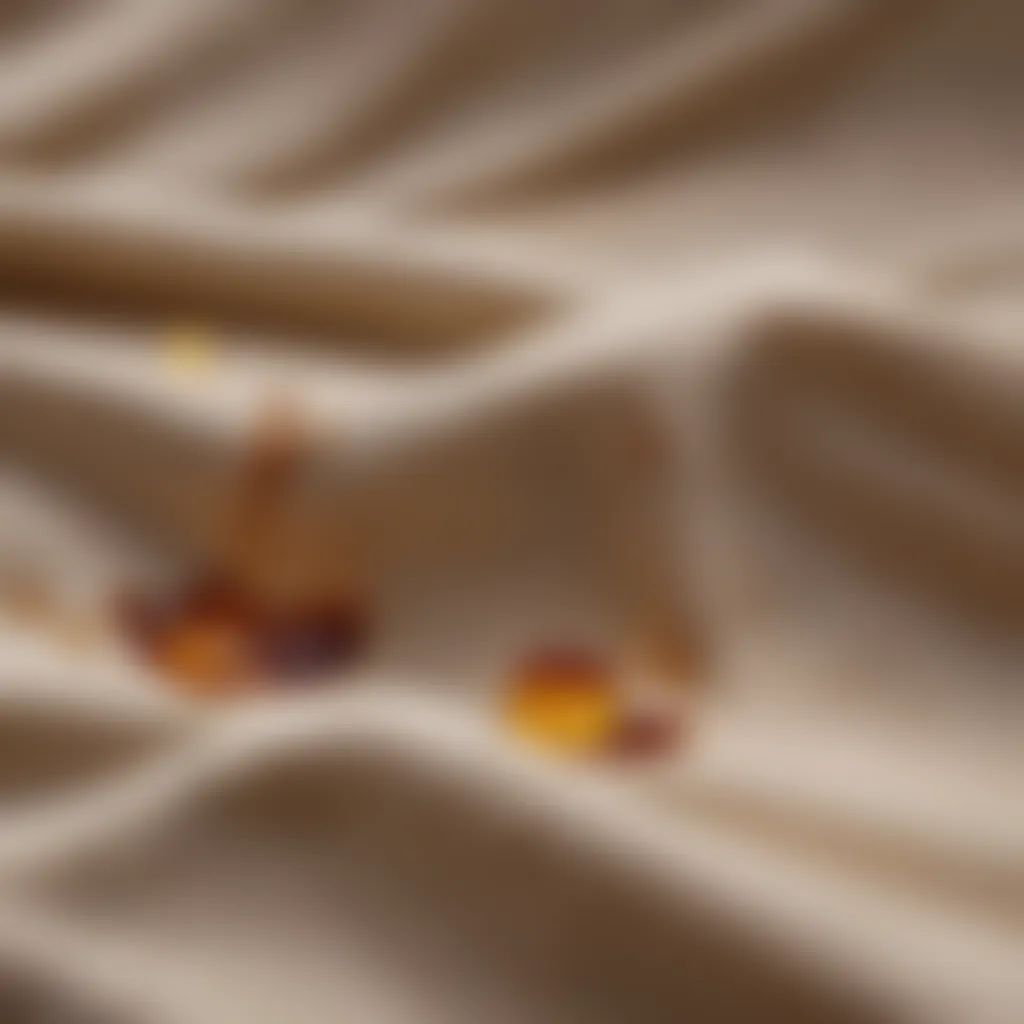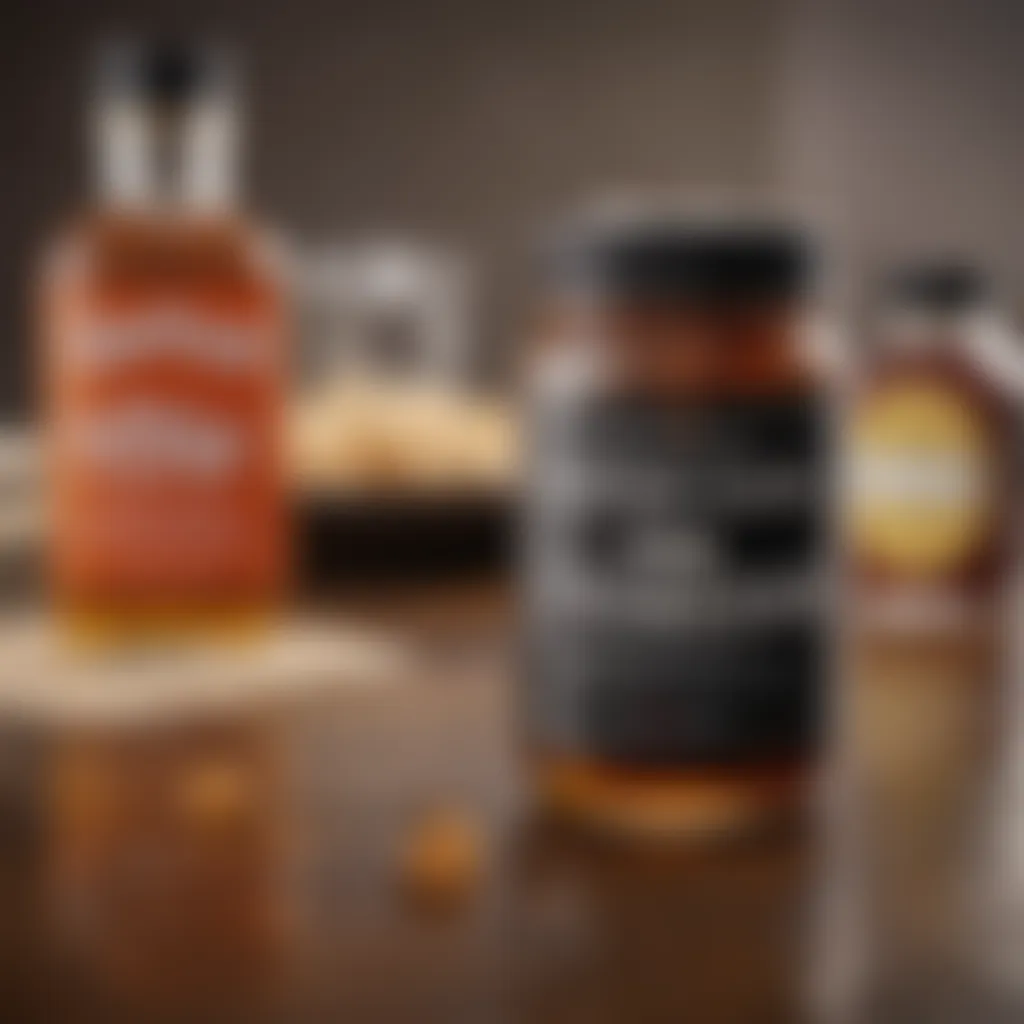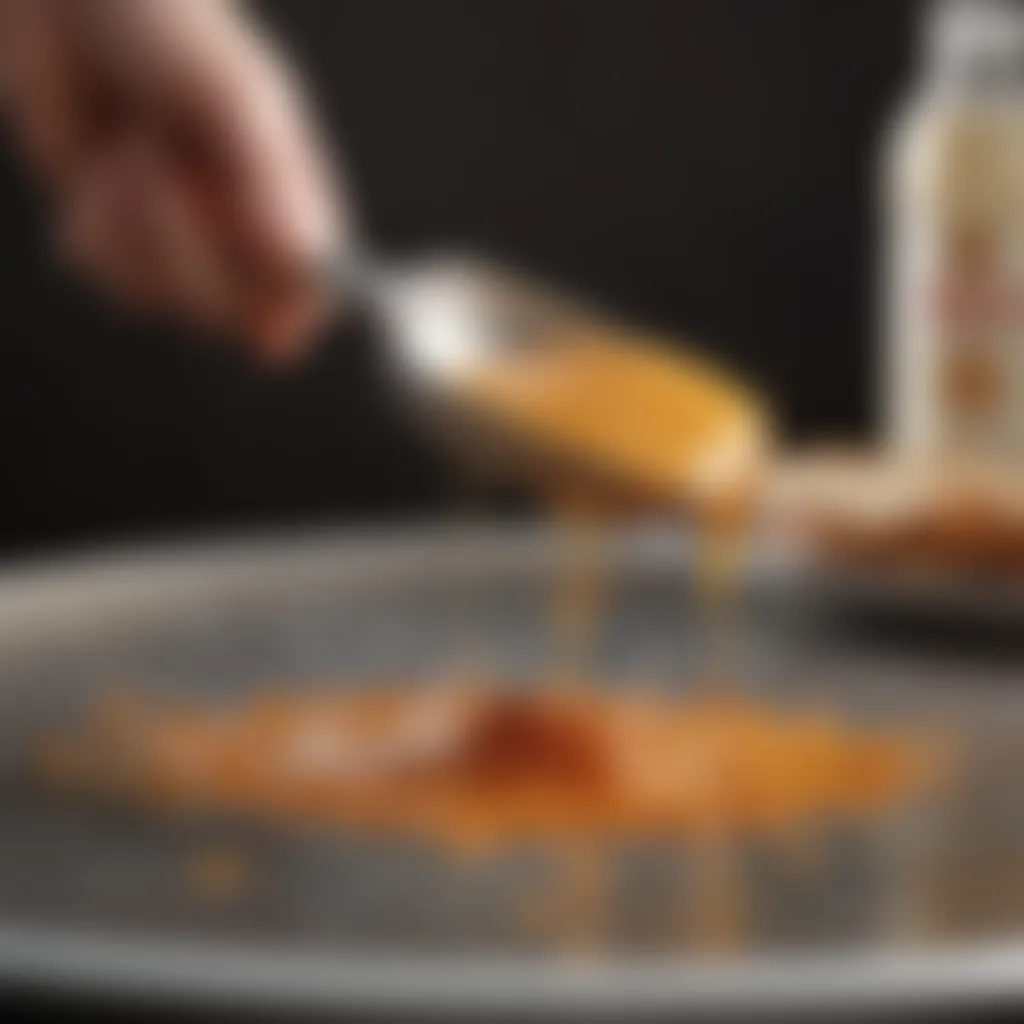Effective Methods to Remove Oil Stains from Clothing


Intro
Oil stains on clothing are a frequent challenge faced by many, particularly in households where cooking and other activities may lead to unwanted spills. The presence of an oil stain can be frustrating and, if not addressed properly, can result in permanent damage to your favorite garments. Understanding the nature of oil stains is crucial for effective removal. Oil, being hydrophobic, does not easily mix with water. Therefore, specialized methods are required to break down the oil and lift it from the fabric.
This guide aims to provide you with numerous techniques to tackle oil stains effectively. Whether you prefer to use household solutions or specialized commercial products, you will find a method that works for your situation. By implementing the tips shared here, you can restore your clothing to its original state and gain confidence in managing this common laundry mishap.
Ingredients:
To effectively remove oil stains, you will need the following ingredients, which can be either household items or commercial products, depending on what you choose to use and what you have available:
- Dish soap: 1 to 2 tablespoons (preferably a degreasing formula)
- Baking soda: 1 tablespoon (optional, for added absorbency)
- White vinegar: 1 tablespoon (optional, for its stain-fighting properties)
- Cornstarch or talcum powder: Sufficient quantity to cover the stain
- Cold water: As needed (for rinsing)
- Commercial stain remover: If preferred, follow the instructions on the product label
Detailed Instructions:
Step 1: Blot the Stain
Start by gently blotting the oil stain with a paper towel or a clean cloth to absorb excess oil. Avoid rubbing, as this may push the oil further into the fibers.
Step 2: Apply an Absorbent
Sprinkle cornstarch or talcum powder generously over the stain. Let it sit for 15 to 30 minutes, as it will help absorb the oil.
Step 3: Brush Off the Powder
After allowing the powder to work, gently brush it off using a soft brush or cloth. You may notice that some oil has been lifted.
Step 4: Apply Dish Soap
Now, apply a few drops of dish soap directly to the stain. Gently work it into the fabric using your fingers or a soft brush, ensuring that the soap penetrates the fibers. Allow it to sit for about 5 to 10 minutes.
Step 5: Rinse with Cold Water
Rinse the area thoroughly under cold running water to remove the dish soap.
Step 6: Additional Treatments (if needed)
If the stain persists, consider repeating the process with white vinegar or a commercial stain remover. Follow the manufacturer's instructions for the product.
Technical Aspects:
When dealing with oil stains, temperature and timing play a critical role. Here are some important factors to consider:
- Water temperature: Always use cold water for rinsing oil stains. Hot water can set the stain, making it more difficult to remove.
- Timing: Do not let the stain set for too long. Acting quickly is essential for the stain-removal success.
Cooking Process:
While removing an oil stain does not involve traditional cooking, following these sequential steps is integral for effective removal:
- Blotting: Quickly blot to absorb excess oil.
- Applying an absorbent: Choose cornstarch or talcum powder.
- Using dish soap: Gently work soap into the fabric.
- Rinsing: Use cold water to clear soap.
- Inspecting: Check for remaining stains and repeat as necessary.
Troubleshooting Tips:
If the stain doesn’t come out on the first try, do not get discouraged. Here are some solutions for common mistakes:
- Stain remains after washing? Avoid using heat to dry the item, as this will worsen the situation. Instead, check the stain and repeat the removal process.
- Stains become darker? This may occur if the cleaning method caused further damage. Test any cleaning solution on a small, inconspicuous area before applying it widely.
Remember, prompt attention and the right approach can restore your clothing effectively.
Understanding Oil Stains
Oil stains are a common issue in household laundry, and they can seem daunting to remove. Understanding the nature and composition of oil stains is crucial. It helps individuals select the right methods and tools necessary for effective cleaning. Better comprehension of oil's characteristics can result in less frustration and better outcomes when tackling these persistent marks.


Nature of Oil Stains
Oil stains originate from various sources, including cooking oils, automotive grease, and even lotions. Each type of oil has its own unique properties, which can influence how it interacts with fabric. Generally, oil stains do not adhere in the same way as water-based stains. This behavior makes them more challenging to remove.
Oil consists of complex mixtures of hydrocarbons. This chemical structure gives oil its viscous nature, allowing for deep penetration into fibers. The longer the stain remains untreated, the more it seeps into the garment. Thus, immediate attention to new oil stains yields better results.
How Oil Interacts with Fabrics
When oil contacts fabric, it does not easily wash away with water. Unlike many stains that can be dissolved or lifted with water and detergent, oil requires a different approach.
Key factors include:
- Fabric Type: Different fabrics absorb oil in distinct ways. Natural fibers like cotton and wool may hold oil deeper than synthetic materials such as polyester. This requires tailored cleaning methods.
- Temperature: Heat can help or hinder cleaning efforts. While hot water might effectively break down grease, it can also set the stain if the fabric is not resistant to high temperatures.
- Oil Properties: Light oils may be easier to remove than heavier oils. Cooking oil with lower viscosity will often lift from fabric with standard cleaners, whereas motor oil will likely require specialized treatments.
Overall, a firm understanding of oil characteristics and their behavior on different fabrics is essential in developing a strategy to approach oil stain removal with confidence.
Immediate Actions to Take
When faced with an oil stain on clothing, the first actions taken can significantly influence the outcome of the stain removal process. Immediate actions are essential for minimizing damage and preventing the stain from setting in. Responding quickly can turn what seems like a disaster into a manageable issue.
Blotting the Stain
The first immediate action is to blot the stain. Blotting must be done carefully; the aim is to absorb as much of the oil as possible without spreading it further. Use a clean, dry cloth or paper towel and gently press it against the stain. Avoid rubbing the fabric, as this can push the oil more deeply into the fibers. This technique is important because the more oil you can remove at this stage, the easier the subsequent cleaning will be.
After blotting the area, it is advisable to check the cloth. If the cloth is saturated with oil, replace it with a fresh one to maximize absorption. Continue this process until the stain looks less prominent. It is crucial not to let the stain dry out during this initial phase, as dry oil can be significantly tougher to remove.
Avoiding Common Mistakes
Many homeowners make several key mistakes when dealing with oil stains, often setting themselves back in the cleaning process. Being aware of these pitfalls can lead to a more effective stain removal experience:
- Do Not Use Hot Water: Using hot water can cook the oil into the fabric, making it much harder to remove. Always start with cold water during the initial rinse or blotting phase.
- Avoid Rubbing the Stain: Rubbing can exacerbate the problem by further embedding the oil into the fabric. Instead, gentle dabbing motions should be employed.
- Don’t Overapply Products: When employing cleaning products, more is not always better. Overusing a product can saturate the fabric and lead to an entirely different set of issues, including residue build-up.
Important Note: It is best practice to test any cleaning solution on an inconspicuous area of the fabric before applying it directly to the stained area. This helps ensure there are no adverse reactions.
By avoiding these mistakes, homeowners can facilitate a more effective and efficient cleaning process for their oil-stained fabrics. Engaging in immediate actions with caution and knowledge will pave the way for successful stain removal.
Home Remedies for Oil Stain Removal
Removing oil stains from clothing is a common challenge many face in everyday life. Home remedies offer a practical solution that is often safe for various fabric types and does not require specialized equipment. These methods use readily available ingredients found in most households, making them economical and accessible options.
Home remedies also allow individuals to avoid harsh chemicals often found in commercial stain removers. Understanding these techniques not only saves money but also provides valuable skills for fabric care. Each method comes with its own set of considerations, effectiveness, and practicality, making it essential to choose the right one for the type of fabric and the severity of the stain.
Baking Soda Application
Baking soda is a versatile ingredient in many households. It acts as a mild abrasive that can gently lift stains while neutralizing odors. To use baking soda, begin by blotting the oil stain with a clean cloth. This step is essential to remove excess oil, as it helps prevent spreading the stain further.
Next, sprinkle a generous amount of baking soda over the stain. Allow it to sit for at least 15 minutes. During this time, the baking soda will absorb the oil, making it easier to remove the stain. Afterward, gently brush off the baking soda with a soft brush or cloth. If the stain remains, repeat the process until the desired result is achieved.
Cornstarch Method
Cornstarch is another effective home remedy for oil stain removal. It operates similarly to baking soda by soaking up the oil from the fabric. To utilize this method, first, blot the stain to remove excess oil, just like before. Then, apply a thick layer of cornstarch directly onto the stain.
Let it sit for at least 30 minutes, but for more stubborn stains, leaving it for a few hours is advisable. Once the cornstarch has done its job, gently brush it off. This should lift a significant amount of the oil. If the stain is still noticeable, a second application may be required.
Dish Soap Solution
Dish soap is not just for dishes. Its grease-cutting properties make it a strong contestant against oil stains. Begin by mixing a few drops of liquid dish soap with warm water to create a soapy solution. After blotting the stain, apply the dish soap solution directly to the affected area. Let it sit for approximately 10 minutes to penetrate the fabric.
Then, gently scrub the area with a soft-bristled toothbrush or cloth. Rinse the fabric under cold water to remove the soap and oil. This method often works quickly and effectively, making it a favorite among many.
Vinegar and Water Mix
Vinegar serves as a natural solvent that can break down oil, making it useful for stain removal. To create this remedy, mix equal parts of white vinegar and water in a bowl. After blotting the stain, apply the vinegar solution directly onto it. Let it sit for about 15 minutes.


Following that, blot the area again with a clean cloth. This method is particularly effective on both fresh and set-in stains. However, it is important to test this solution on a small, hidden area of the fabric first to ensure color fastness.
Using home remedies, like baking soda and vinegar, can save both time and money when dealing with oil stains.
By understanding how these simple kitchen ingredients work, individuals can maintain their clothing better, reduce waste, and improve their overall fabric care skills.
Commercial Products for Oil Removal
In the quest to remove oil stains from clothing, commercial products play a pivotal role. They provide solutions that are often more powerful and targeted than household remedies. With various options available, consumers can select products suitable for different fabric types and specific stain conditions. The effectiveness of these commercial removers stems from advanced formulations designed to break down oil molecules. However, as important as effectiveness is, it becomes crucial to consider safety, fabric compatibility, and specific instructions for use. Choosing a commercial product requires careful thought to ensure it aligns with the goals of stain removal without compromising the garment's integrity.
Stain Remover Sprays
Stain remover sprays have become a household staple for those battling oil stains. These products are specially formulated with ingredients aimed at dissolving oil while being easy to apply. Sprays offer convenience, allowing precise targeting of the stain area without oversaturating the fabric. It is essential to consider the spray's composition, as some may contain harsh chemicals that could damage delicate materials. When using spray stain removers, the application process is vital. To enhance effectiveness, hold the canister several inches away from the stain and apply it evenly.
Benefits of Stain Remover Sprays:
- Quick application.
- Direct targeting of stains.
- Typically effective on a wide range of fabric types.
Laundry Detergent Selection
Selecting the right laundry detergent can significantly affect the outcome of oil stain removal efforts. Not all detergents are created equal, especially when it comes to breaking down grease. For optimal result, look for detergents labeled as "heavy duty" or "specialized for stain removal." These formulations often contain enzymes and other additives that enhance stain-fighting power.
In addition, it is essential to follow the manufacturer’s instructions regarding dosage. Using too little may not yield satisfactory results, while using too much could waste product and possibly harm the fabric. For best practices, apply detergent directly to the stain, let it sit for a specified time, and then wash according to the care label instructions.
Specialized Oil-Removing Solutions
Specialized oil-removing solutions are available in the market that focus solely on breaking down oil-based stains. These products often contain solvents, surfactants, or both, designed to penetrate the fabric fibers and dissolve the oil. When considering applying these solutions, read the label carefully and test on an inconspicuous area first, particularly for sensitive fabrics. Some notable brands that offer targeted oil removers include Zout, OxiClean MaxForce, and Shout Advanced Gel.
Advantages of Specialized Solutions:
- Tailored formulas specifically designed for oil.
- Often contain professional-grade ingredients.
- Provide an option for persistent or aged oil stains.
Always remember, before applying any commercial product, to check the fabric care label and conduct a patch test to avoid any unexpected damage.
Techniques for Stain Removal
Understanding the techniques for stain removal is crucial in the battle against oil stains. Oil stains can be particularly stubborn, requiring specific approaches to eliminate them effectively. The right method can produce impressive results, restoring fabrics to their original state. Knowledge of these techniques enables individuals to act decisively and with confidence when faced with unsightly marks on clothing. Each method has unique benefits, considerations, and suitability depending on the type of fabric and the nature of the stain.
Cold Water Rinse Technique
The cold water rinse technique is often overlooked but can be very effective. Initially, it is important to act quickly after the oil stain occurs. Rinsing the fabric under cold water can help in flushing out a significant portion of the oil. This technique works best for fresh stains. The cold temperature prevents the oil from setting deeper into the fibers, which is a common issue with warm or hot water. When using this method, it is essential to run the water directly onto the back of the stain. This will push the oil out of the fabric instead of embedding it further.
- Step-by-step execution:
- Turn the fabric inside out.
- Place it under a cold running tap.
- Ensure the water flows directly onto the stain for better effect.
While this method does not entirely eliminate the stain, it prepares the fabric for further treatments. It can reduce the size and visibility of the oil mark significantly.
Layered Application Method
The layered application method is a more comprehensive approach to tackle persistent oil stains. This method implies using multiple products, building an effective treatment for tougher stains. By applying one solution after another, you can create a potent reaction that breaks down the oil.
When using this method, choose products wisely. For instance, a combination of dish soap and vinegar can work wonders, where each application targets different aspects of the oil stain. Layering enhances the effectiveness of the cleaning agents, allowing them to interact and, in many cases, pull the stain from the fibers effectively.
- Suggested layered steps might include:
- First layer: Apply dish soap directly to the stain and gently rub it in.
- Second layer: Once rinsed, apply a vinegar solution to neutralize any leftover residue.
- Third layer: Finish with a stain remover spray before washing thoroughly.
Careful execution of this method provides a more significant chance of removing deep-set oil stains. However, it requires persistence and attention to detail.
Soaking Strategies
Soaking strategies provide an effective means to deal with oil stains, especially when they are more than just surface issues. This method allows the cleaning agents ample time to penetrate the fabric deeply, breaking apart the oil molecules. It is suitable for items made of durable materials that can withstand extended exposure to water.


When employing soaking techniques, you have various options. You can opt for a simple water and detergent mix or a more targeted solution using specialized stain removers. A bucket or sink filled with the chosen solution creates a controlled environment for the fabric to be treated thoroughly.
- Consider the following soaking steps:
- Fill a basin with cold water and add a generous amount of laundry detergent.
- Submerge the stained clothing completely and allow it to soak for at least 30 to 60 minutes.
- After soaking, gently agitate the item to help lift the stain before washing normally.
This method works well for various fabrics, ensuring the oil is tackled effectively over time before proceeding to wash, improving the chance of successful stain removal.
Effective stain removal often relies on knowledge and prompt action. Adopt suitable techniques to ensure your clothing is cared for properly.
Post-Cleaning Care
PostCleaning care is a critical phase after dealing with oil stains. It plays a significant role to secure that the stain is entirely removed and the fabric is not damaged. Many people might overlook this step, thinking that cleaning is done once the visible stain disappears. However, the proper inspection before drying and ensuring repeated cleaning, when necessary, can significantly affect the longevity of your clothing.
Inspection Before Drying
After treating the oil stain, it is essential to inspect the fabric thoroughly before proceeding to drying. Fabrics can hide residual oil, which might not be visible at first glance. If any oil remains in the fibers, it can become set in the material during the drying process, making future stain removal challenging.
- Check the Affected Area: Look closely at the spot that was treated. If any discoloration or greasiness is visible, it indicates that the oil has not been completely removed.
- Test for Visibility: Use a clean, dry cloth to dab gently onto the stain location. If the cloth picks up even a little oil, you will need to repeat the cleaning steps.
- Evaluate Fabric Reaction: Different fabrics react uniquely to cleaning methods. Synthetics might respond differently compared to cotton or wool. Evaluating how each material interacts might guide the steps you take for repeat cleaning.
In summary, inspecting your clothing before drying is a preventative measure against stubborn stains setting in.
Repeated Cleaning if Necessary
If the inspection reveals that the stain persists, it is crucial to repeat the cleaning process. This step should not be treated as an additional inconvenience. Rather, it is a necessary action to retain the quality of the clothing. Here are important considerations:
- Reapply Your Chosen Method: Depending on the method used initially, you should decide whether you want to use the same solution or try another approach for better results.
- Be Patient: Sometimes, oil stains require multiple treatments, especially if they have been allowed to dry initially. Do not rush this process.
- Follow Guidelines: Ensure that when you repeat the cleaning, you are still following care instructions appropriate for the fabric. For example, harsher solvents may not be suitable for delicate fabrics.
Should repeated cleaning be required, remember to conduct another inspection before drying yet again to ensure complete oil removal.
"A thorough approach to cleaning not only preserves clothing but also avoids further damage from the stain setting in."
By taking the time for vigilant inspection and potential repeated cleaning, you can vastly improve your chances of effectively removing oil stains from your clothing. The result is not just a clean item, but one that is fit for continued use.
Preventative Measures
Preventing oil stains before they happen is often easier than removing them after they have set into fabric. Adopting preventative measures can save time, reduce frustration, and maintain the integrity of clothing. This section outlines two key strategies for minimizing the risk of oil stains: careful handling of oily items and selecting appropriate fabrics.
Careful Handling of Oily Items
Being mindful when handling items that may cause oil stains is crucial. Always store oily foods or substances in leak-proof containers. This applies to cooking oils, sauces, or any greasy items. If you are cooking, using an apron can provide an extra barrier against splatters, reducing the chance of unwanted stains on your clothing.
When it comes to cleaning or preparing oily items, take your time. Avoid rushing, as that may lead to accidental spills. If a spillage does occur, blot the area immediately with a cloth or paper towel, rather than rubbing, as this action could set the stain deeper into the fabric.
Key tips for handling oily items:
- Always keep oily items separated from clothing when possible.
- Use utensils that are less likely to cause splatter or spills.
- Clean any surfaces where oily items are placed immediately to prevent cross-contamination.
Choosing the Right Fabrics
When selecting clothing and linens, consider the fabric. Fabrics with tighter weaves or treated surfaces can resist staining better than loose weaves. Synthetic fibers like polyester are often more oil-resistant compared to natural fibers like cotton.
Furthermore, some fabrics can be treated with stain-resistant coatings before purchase. Investing in such items may offer additional assurance against future stains. This preventive purchase can save both time and money, as treating stained clothing can be far more tedious and costly.
Factors to consider when choosing fabrics:
- Look for tight weaves that can repel liquids better.
- Choose synthetic fibers for their inherent stain-resistant properties.
- Opt for fabrics treated with stain-resistant solutions.
Practicing careful handling and choosing the right fabrics can significantly reduce the likelihood of encountering oil stains on your clothes.
By incorporating these preventative methods into daily life, readers can effectively shield their garments from the trials of oily stains, ultimately prolonging the lifespan of their wardrobe and enhancing their overall laundry experience.
Culmination
Addressing oil stains promptly and using the correct method ensures that garments are preserved rather than damaged. When analyzing the various techniques, it is important to note that the right choice often depends on the type of oil, the fabric, and how long the stain has been present.
Key points to consider include:
- Immediate Response: Blotting the stain as soon as it occurs can significantly increase the likelihood of complete removal.
- Home Remedies vs. Commercial Products: Each method has strengths depending on what is readily available and which appeals more to the user's preferences.
- Understanding Fabric Interactions: Some fabrics are more resilient or susceptible to staining than others, which influences the choice of treatment.







